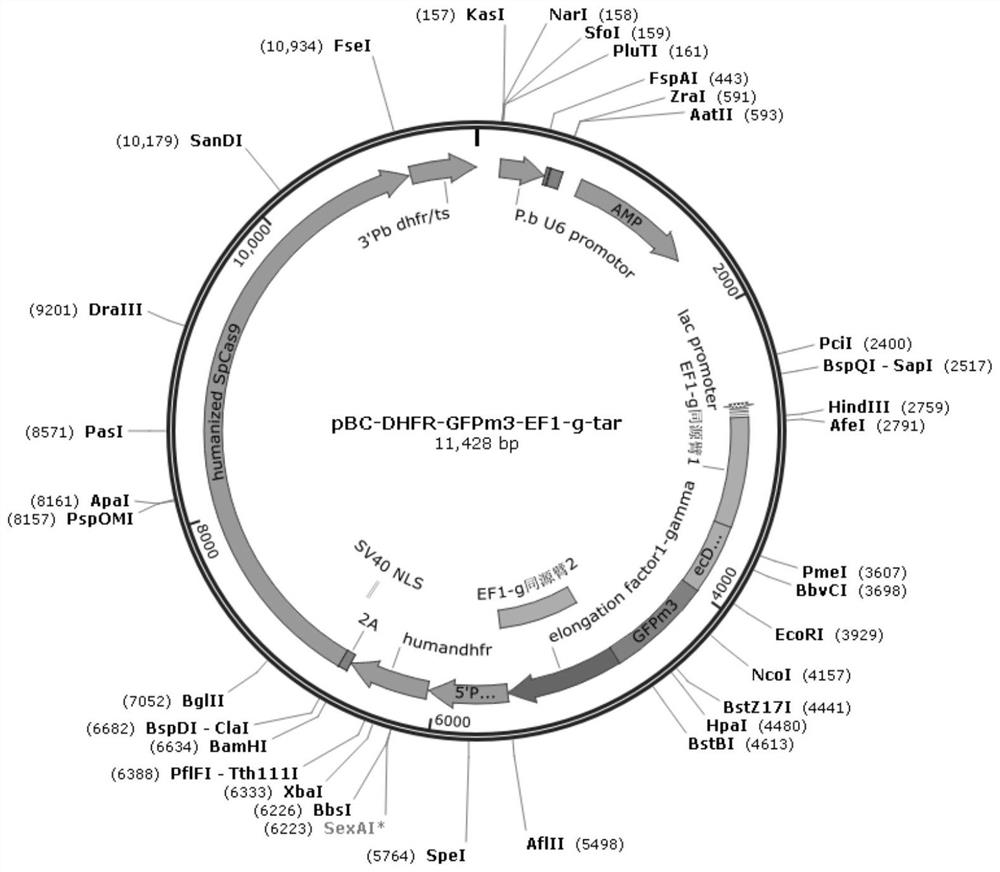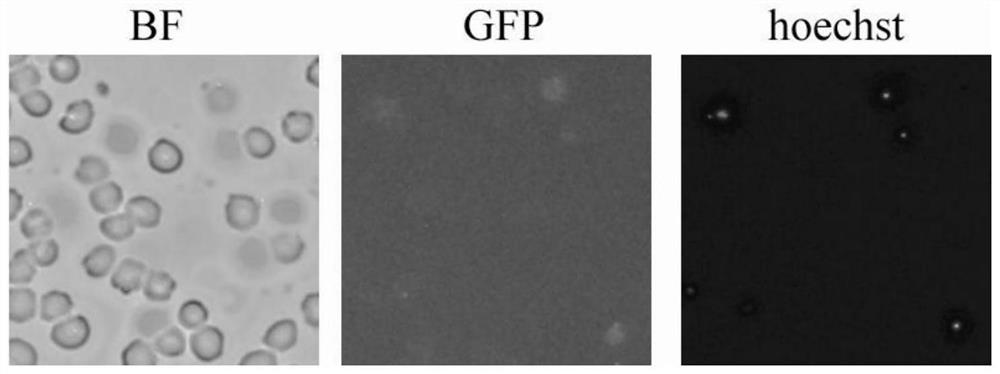A detoxification system and its application
A technology of recombining vectors and genes, which is applied in the field of genetic engineering, can solve the problems that proteins cannot be regulated, and achieve the effects of convenient regulation, good regulation effect and low background
- Summary
- Abstract
- Description
- Claims
- Application Information
AI Technical Summary
Problems solved by technology
Method used
Image
Examples
Embodiment 1
[0057] Example 1 Construction of a strain of Plasmodium berghei P.bANKA using DDD to regulate the EF1g gene
[0058] In this example, the Cas9 knock-in vector pBC-DHFR-GFPm3-EF1g-Tar is constructed. The vector diagram is as follows figure 1 As shown, the vector is Amp resistant, contains a tandem expression of Cas9 protein and the Plasmodium pyrimethamine resistance gene hDHFR, using the pbeef1aa promoter, the Cas9 gene and hDHFR gene are linked by 2A peptide, using 3'Pb dhfr / ts as a terminator. In addition, the vector also contains a fusion expression cassette that uses the pbeef1aa promoter to contain EF1g homology arm 1, regulatory element DHFR, reporter protein GFP and EF1g downstream homology arm sequences in tandem, using 3'Pb dhfr / ts as a terminator, the vector also contains a P.b U6 promoter for sgRNA expression.
[0059] The EF1g gene homology arms are shown in SEQ ID NO.4-5, the sgRNA primers are shown in SEQ ID NO.6-7, and the specific sequences are shown in Tabl...
Embodiment 2
[0069] Example 2 Verifying the effect of using DDD to regulate the EF1g gene in P. berghei P.bANKA
[0070] Two Balb / c (8w, female) mice were inoculated with the P.bNAKA / pBC-DHFR-GFPm3-EF1g-Tar strain, and one mouse was inoculated with P. berghei using the CRISPR-Cas9 system to knock out the non-essential gene NT1 as a For the control, mixed administration of TMP / pyrimethamine was performed first, and the drug withdrawal TMP experiment was performed after the infection rate of Plasmodium exceeded 1%. After drug withdrawal, blood smears were taken for mice to calculate the infection rate. The results are as follows: Figure 5 shown.
[0071] from Figure 5 It can be seen that the mice in the control NT1 group died 7 days after drug withdrawal, while the infection rate of all mice in the DDD-EF1g group decreased to 0; After drug withdrawal, the infection rate continued to rise and died after 5 days, while the infection rate of 2 DDD-EF1g group mice dropped to 0 5 days after d...
Embodiment 3
[0073] Example 3 The effect of using DDD to regulate the EF1g gene in Plasmodium berghei P.bANKA
[0074] In this example, a DDD-GFP strain constructed by our company (DDD system regulates GFP expression, but does not regulate essential genes) was inoculated into Balb / c (8w, female) mice to verify whether there was TMP residue after TMP withdrawal. In addition, the DDD-EF1g strain was inoculated into 6 Balb / c (8w, female) mice, and the administration methods of the mice were shown in Table 2:
[0075] Table 2 Mice grouping and dosing table
[0076]
[0077] After the Plasmodium infection rate exceeded 1%, the G1 and G3 groups were withdrawn. Before withdrawal, the GFP fluorescence of the DDD-EF1g strain was observed, and the results were as follows Image 6 As shown, after TMP withdrawal, the G1 fluorescence was observed, and the results were as follows Figure 7 As shown, the infection rate and survival rate of mice in each group are as follows Figure 8(A)-Figure 8(B) ...
PUM
 Login to View More
Login to View More Abstract
Description
Claims
Application Information
 Login to View More
Login to View More - R&D
- Intellectual Property
- Life Sciences
- Materials
- Tech Scout
- Unparalleled Data Quality
- Higher Quality Content
- 60% Fewer Hallucinations
Browse by: Latest US Patents, China's latest patents, Technical Efficacy Thesaurus, Application Domain, Technology Topic, Popular Technical Reports.
© 2025 PatSnap. All rights reserved.Legal|Privacy policy|Modern Slavery Act Transparency Statement|Sitemap|About US| Contact US: help@patsnap.com



